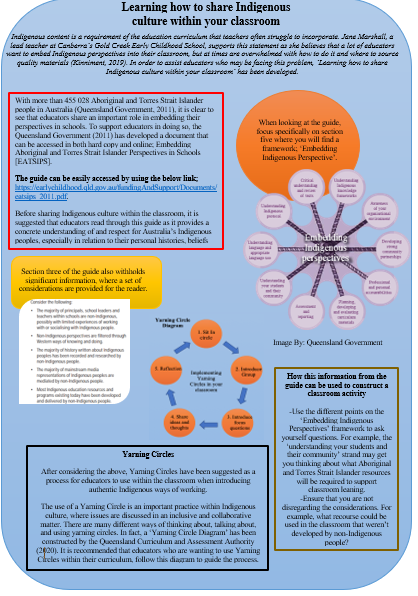11 Guidelines for embedding Aboriginal and Torres Strait Islander perspectives
Brianna Parker
All humans have culture, and educational contexts do too (USQ, 2020). Culture isn’t just shared recipes, language or traditions; it is a lived experience unique to each individual. From this, it is clear to see that teachers hold a role in understanding the cultures they are working with. In fact, Early Childhood Australia (2011) states that, educators have a significant responsibility to “contribute to Australia’s reconciliation agendas concerning Aboriginal and Torres Strait Islander children and families” (p. 1). To address educator concerns in relation to this responsibility, a digital information sheet ‘Learning how to share Indigenous culture within your classroom’ has been developed. This resource could be first introduced to educators in a staff meeting, as a form of professional development suggested by the principal, or perhaps in employment packages to deliver foundational advice and direction on how and where to embed appropriate Indigenous ways of working into the curriculum.
Through websites suggested within the resource, an educator can find relevant information to Aboriginal and Torres Strait Islander perspectives. For example, this resource provides access to a guide Embedding Aboriginal and Torres Strait Islander Perspectives in schools (Queensland Government, 2011). Directing focus on systematic change, this guide also brings cultural awareness to educational settings as it highlights meaningful connections to people, land and ancestry through frameworks and considerations as presented in the resource. Information from the guide has been adapted within the resource to provide educators with a suggested activity to utilise where students learn through Aboriginal culture, not just about Aboriginal culture (Queensland Government, 2011). For example, the Yarning Circle has been recommended as an appropriate process as learnings from it recognise and respect the continuing connection that Indigenous peoples have to Country. In whichever situation they are used, Yarning Circles also allow children to foster a greater sense of belonging to the service as they share their stories with others
Links
Early Years Learning Framework (DEEWR, 2009)
- Outcome 1: Children have a strong sense of identity
- 1.1: Children feel safe, secured and supported
- Outcome 2: Children are connected with and contribute to their world
- 2.1: Children develop a sense of belonging to groups and communities and an understanding of the reciprocal rights and responsibilities necessary for active community participation


